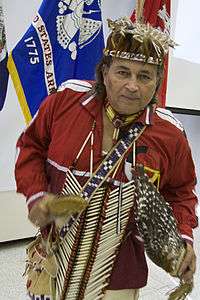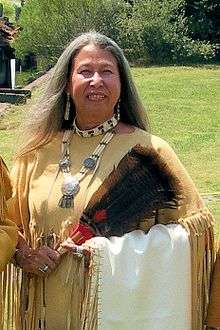Nottoway people
The Nottoway (Nottoway) are a Native American tribe in Virginia. Historically, the Nottoway spoke an Iroquoian language and were related to other Iroquoian speakers.
 Chief Walter D. "Red Hawk" Brown III of the Cheroenhaka (Nottoway) Indian Tribe | |
| Total population | |
|---|---|
| Courtland, Virginia Cattashowrock Reservation : 500 | |
| Regions with significant populations | |
| Southampton County, Virginia Alexandria, Virginia | |
| Languages | |
| English, Iroquoian Nottoway (historical) | |
| Related ethnic groups | |
| Nansemond, Chowanoke, Susquehannock, Meherrin, Tuscarora, Iroquoian people |
 Chief Lynette Allston of the Nottoway Indian Tribe of Virginia | |
| Total population | |
|---|---|
| Nottoway Indian Tribe of VA: Southampton County into Surry County: 180 | |
| Regions with significant populations | |
| Languages | |
| English, Iroquoian Nottoway (historical) | |
| Related ethnic groups | |
| Meherrin, Tuscarora, Nansemond, Chowanoke |
The Nottoway Indian Tribe of Virginia live from Southampton County into Surry County and the Tidewater region,[1] and the Cheroenhaka (Nottoway) Indian Tribe live in Southampton County in their traditional tribal territory called Cattashowrock Town in Courtland.[2] Since colonial times, treaties by regional government with the Nottoway attested to their presence as a distinct people.
The Nottoway Indian Tribe of Virginia and the Cheroenhaka (Nottoway) Tribe are distinct, with separate identities. Each of the contemporary tribes received state recognition in February 2010.[3][4] They were among several Virginia tribes that were deprived of their land during the colonial era and their records were distorted during the early 20th century. The Cheroenhaka (Nottoway) Indian Tribe has filed their letter of intent to petition for federal recognition and hope to receive federal recognition soon.
The Chickahominy, Eastern Chickahominy, Rappahanock, Nansemond, Monacan, and Upper Mattaponi received federal recognition in January 2018. The Pamunkey tribe was granted federal recognition in 2015. Four state-recognized tribes in Virginia are still seeking federal recognition: the Nottoway Indian Tribe, Cheroenhaka (Nottoway) Tribe, Mattaponi Indian tribe and Reservation, and Patawomeck tribe.
Name
The meaning of the name Cheroenhaka (in Tuscarora: Čiruʼęhá·ka·ʼ[5]) is uncertain. (It has been spelled in various ways: Cherohakah, Cheroohoka or Tcherohaka.) The late Iroquoian scholar Blair A. Rudes analyzed the second element as -hakaʼ meaning "one or people who is/are characterized in a certain way". He conjectured that the first element of the name was related to the Tuscarora term čárhuʼ (meaning "tobacco", as both tribes used this product in ceremonies).[6] The term has also been interpreted as "People at the Fork of the Stream".[7]
The term Nottoway may derive from Nadawa or Nadowessioux (widely translated as "poisonous snake"), an Algonquian-language term. Algonquian tribes occupied the coastal areas and used this term to refer to the Iroquoian- or Siouan-speaking tribes of the interior, with whom they competed. Because the Algonquian occupied the coastal areas, they were the first tribes met by the English. The colonists often adopted use of such Algonquian ethnonyms, names for other tribes, not realizing at first that these differed from the tribes' autonyms, or names for themselves.
Frank Siebert suggests the term natowewa stems from Proto-Algonquian *na:tawe:wa and refers to the Massasauga, a pit viper of the Great Lakes region. The extension of the meaning as "Iroquoian speakers" is secondary. In Algonquian languages beyond the geographical range of the viper (i.e. Cree–Innu–Naskapi and Eastern Algonquian), the term's primary reference continues to focus on *na:t- 'close upon, mover towards, go after, seek out, fetch' and *-awe: 'condition of heat, state of warmth,' but no longer refers to the viper.
Instead, particularly in the South, the 'Iroquoian' designation is primary. The semantic meaning may not relate to snakes at all, but refer to the cultural trading position of the Virginia-Carolina Iroquois as middle men between Algonquian and Siouan speakers. Other historical developments in Algonquian languages extend the meaning of *-awe to 'fur or hair' (i.e. Cree, Innu, Ojibway, Shawnee), an obvious relationship to 'state of warmth.' A potential etymology in Virginia of *na:tawe:wa (Nottoway) refers to *na:t- 'seeker' + -awe: 'fur,'[8] or literally 'traders'[9] The earliest colonial Virginia reference to "Nottoway" also frames Algonquian/Iroquoian exchanges in terms of trade: roanoke (shell beads) for skins (deer and otter).[10]
The Algonquian speakers also referred to the Nottoway, Meherrin and Tuscarora people (also of the Iroquoian-language family) as Mangoak or Mangoags, a term which English colonists used in their records from 1584 to 1650. This term, Mengwe or Mingwe, was transliterated by the Dutch and applied to the Iroquoian Susquehannock ("White Minquas") and Erie people ("Black Minquas"). Another variation was the later term Mingo, which English-speaking colonists and settlers used to refer to descendants of remnant tribes who had been partly assimilated into the Six Nations of the Iroquois and later migrated into Ohio and the Midwest.
Language
The Nottoway language became extinct well before 1900.[11] At the time of European contact (1650), speakers numbered only in the hundreds. From then until 1735, a number of colonists learned the language and acted as official interpreters for the Colony of Virginia, including Thomas Blunt, Henry Briggs, and Thomas Wynn. These interpreters also served the adjacent Meherrin, as well as the Nansemond, who spoke Nottoway in addition to their own Algonquian dialect of Powhatan.[12] The last two interpreters were dismissed in 1735, since the Nottoway by then were using English.
By 1820, three elderly speakers of Nottoway were said to remain.[13] In that year John Wood collected over 250 word samples from one of these, Chief "Queen" Edith Turner. He sent them to Thomas Jefferson, who shared them with Peter Stephen Du Ponceau. In their correspondence, these two men quickly confirmed that the Nottoway language was of the Iroquoian family. Several additional words, for a total of about 275, were collected by James Trezvant after 1831, and published by Albert Gallatin in 1836.
In the early 20th century, John Napoleon Brinton Hewitt (1910) and Hoffman (1959) analyzed the Nottoway vocabulary in comparison with Tuscarora, also Iroquoian, and found them closely related. The Tuscarora had lived in North Carolina, likely migrating there from the Great Lakes area thousands of years before. Due to warfare and colonial pressure in the early eighteenth century, most of the surviving Tuscarora migrated north to New York to seek protection by alliance with the Iroquois Confederacy. They were accepted as its Sixth Nation. They declared their migration ended in 1722, and said that Tuscarora living elsewhere were no longer considered members of the tribe. A significant population in North Carolina claim descent from the Tuscarora and identify by that name.
Since the early 2000s, the Cheroenhaka (Nottoway) Indian Tribe has been working hard to revitalize their traditional language, using Tuscarora vocabulary and grammar. The two languages are mutually intelligible and vary only in terms of dialect.
History
The Nottoway, like their close Iroquoian neighbours, the Meherrin and Tuscarora, lived just west of the Fall Line in the Piedmont region. English explorer Edward Bland is believed to have been the first European to encounter them, when he made an expedition from Fort Henry. He noted meeting them in his journal for August 27, 1650. At the time, the people numbered no more than 400–500. Bland visited two of their three towns, on Stoney Creek and the Rowantee Branch of the Nottoway River, in what is now Sussex County. These towns were led by the brothers Oyeocker and Chounerounte.
The Nottoway and Meherrin became friendly with the English. They were the only tribes to send warriors to help the English against the Susquehannock (also an Iroquoian tribe) in 1675. Following Bacon's Rebellion, both tribes signed the Treaty of 1677, becoming Tributary Nations to the Colony of Virginia.
By 1681, hostile tribes caused the Nottoway to relocate southward to Assamoosick Swamp in modern Surry County. In 1694 they moved again, to the mouth of a swamp in what is now Southampton County. Around this time, they absorbed the remnants of the Eno — an Algonquian-speaking tribe that had formerly been part of the Powhatan confederacy.[14] In the early 1700s, the Nottoway also absorbed a group of Nansemond known as the "Traditional Nansemond." The Nansemond were the only Powhatan tribe that regularly traded with the Nottoway and spoke the Nottoway language. In a court case against tribal treasurer Jeremiah Cobb in 1849-1852, James and Jincy Taylor were identified as headmen who led the "Nottoway and Nansemond Tribe of Indians."
Although never numerous, the Nottoway maintained cultural continuity. They did not disappear from records identified as Indian, merge into other tribes, or get pushed too far from their original homeland. Scholars believe the early Nottoway were similar in culture to the Tuscarora and Meherrin. The Nottoway, much like the Tuscarora, consisted of 7 clans: Wolf, Deer, Eel, Beaver, Bear, Snipe, and Turtle. The tribe depended on the cultivation of staples, such as the three sisters — varieties of maize, squash, and beans. The cultivation and processing of crops was typically done by women, who also selected and preserved varieties of seeds to produce different types of crops. The men hunted game and fished in the rivers. They built multi-family dwellings known as longhouses in communities which they protected by stockade fences known as palisades.
The Nottoway suffered high fatalities from epidemics of new Eurasian diseases, such as measles and smallpox, to which they had no natural immunity. These accompanied European contact, as the diseases were by then endemic among Europeans. Tribal warfare and encroaching colonists also reduced the population.
When the Tuscarora migrated northward ca. 1720 to become the Sixth Nation of the Iroquois Confederacy in New York, some Nottoway also migrated there, while others remained in Virginia. It is likely that some descendants of the Iroquois nations, especially among the Tuscarora and Oneida, with whom they lived in New York and Canada, also have Nottoway ancestry.
Some Nottoway returned to the South, with bands of Tuscarora and Meherrin joining and merging with them. These groups went to South Carolina.
In the 21st century, some common surnames among the Nottoway are Turner, Woodson, Rogers/Roger, Bozeman, Wineoak, Weaver, Bass, Step, Skipper, Kersey, Bennett, Blount, Scholar, Robins, Williams/Will, Edmunds, Bartlett, Bailey, Gabriel, Pearch, Kello, Walden, John, and Taylor.
References
- Nottoway Indian Tribe of Virginia, Inc., Nottoway Indian Tribe of Virginia, Inc.
- Cheroenhaka (Nottoway) Indian Tribe, Cheroenhaka (Nottoway) Indian Tribe
- SJ12 Nottoway Indian Tribe; extending state recognition thereto and grants representation on VCI., Legislative Information System
- SJ127 Cheroenhaka (Nottoway) Indian Tribe; extending state recognition thereto, representation on VCI., Legislative Information System
- Rudes, Blair A. Tuscarora English Dictionary Toronto: University of Toronto Press, 1999
- Rudes, Blair, Sketch of the Nottoway Language from a Historical-Comparative Perspective, University of Chicago Press, 1981.
- Cheroenhaka Nottoway Indian Tribe History
- Siebert, Frank T. (1996) Anthropological Linguistics, Vol. 38, No.4, pp. 635–642.
- Woodard, Buck (2010). Ethnographic View of the Nottoway, 1700–1750
- Bland, Edward (1650). The Discovery of New Brittaine
- Rudes, Sketch of the Nottoway Language.
- Helen Rountree, Pocahontas's People p. 108.
- Rudes, Sketch of....
- Thomas C. Parramore, 1978, Southampton County p.1-5.
- Cheroenhaka (Nottoway) Indian Tribe Location-27345 Aquia Path - Cattashowrock Trail, Cattashowrock Town, Courtland, VA 23837
Further reading
- "Cheroenhaka (Nottoway) State and Federal Recognition", Cheroenhaka website
- Swanton, John R. The Indian Tribes of North America. Smithsonian Institution Bureau of American Ethnology Bulletin 145. Washington DC.: Government Printing Office, 1952.
- Hodge, Frederick W. Handbook of North American Indians. Washington, DC.: Government Printing Press, 1910.
External links
- Cheroenhaka (Nottoway) Indian Tribe, Website
- Nottoway Indians of Virginia, Inc., Website
- Nottoway language Swadesh vocabulary list (from Wiktionary)